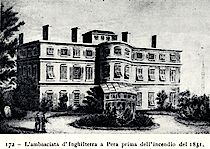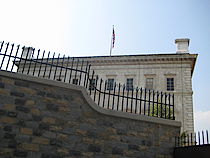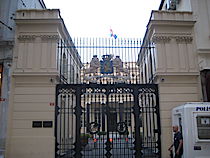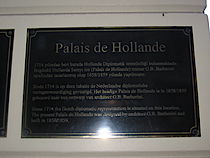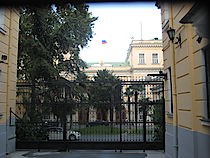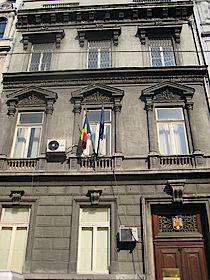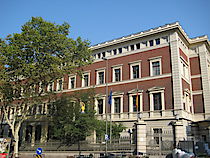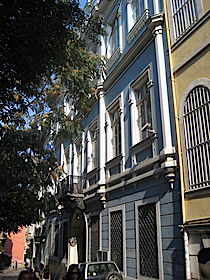I. European Basic Data
a. Osmanli or Ottoman, the Imperial House of Osman
c. Ottoman and European Rulers Index
b. A Risky Job - Laying Out History
c. The Table of Ottoman-European Diplomats
a. Data on States of the Performances
c. The Table of Diplomats' Operas
The three following parts, rulers, ambassadors and ambassadors' operas are the three corners, or three "supporting pillars" of the research. These three pillars are the European basic data, which enable the research to develop; for without these basic data it would not be possible to conduct sound research on these two fields, opera and diplomacy.
As we deal with the history of diplomacy and that of opera in Ottoman world and Europe, we necessarily must possess an overview of empires, kingdoms, states and their almighty rulers, as well as of our subject matter, the ambassadors who play a remarkable role in opera history. Therefore we present them as our "three supporting pillars".
These basic data are presented in three compilations conducted by Don Juan Archiv Wien, and provide scholars, researchers and the enthusiasts of the fields with the above-mentioned interrelations not only an "overview" of the relevance of diplomacy and opera in context of Ottoman and European history; but also as reference to further research. The compilations may also serve as source for further/other publications.
1. Rulers
This study registers in detail the Ottoman Sultans and the European rulers chronologically, and is meant to provide background and support for the projects "Diplomacy as Cultural Exchange" and "Ottoman Empire and European Theatre".
a. Osmanlı or Ottoman, the Imperial House of Osman
The entire eighteenth century falls into the Stagnation Era (1683-1827) of the Ottoman Empire beginning with the defeat of the Second Siege of Vienna. But surprisingly, or contradictorily, this era is also when extensive reforms in various areas were instituted by certain extraordinary members of the House of Osman.
b. The Three Reformer Sultans
Selim III (r. 1789-1807), Mahmut II (r. 1808-1839) and Abdülmecid I (r. 1839-1861) are mostly known as the reformer Sultans of the Ottoman dynasty, who implemented significant military, diplomatic, legal and social reforms. Nevertheless, a more important common characteristic of them was their affinity to musical-scenic arts. Selim III was a highly talented composer and poet and the first Sultan known to invite an opera troupe to the court. Mahmut II to establish the first military band except that of the Mehter, invited Giuseppe Donizetti, who established the first Ottoman orchestra and trained many musicians. His heir to the throne, Abdülmecid I, an advocate of reforms like his predecessor and father Mahmut II, was also a true enthusiast of classical music, theatre and opera, thus closely befriended with Giuseppe Donizetti, and was the founder of the first court theatre at the Dolmabahçe Palace (est. 1859).
c. Ottoman and European Rulers Index
We believe it is not possible to conduct sound research on theatre, opera or cultural history without having an overview of the historical facts of the era we analyze. Therefore, it was essential to map the Ottoman-European history through the rulers in history, so the Ottoman and European Rulers Index serve to this aim.
2. Ambassadors
The project also includes a section which enlists the register data of the Ottoman envoys and ambassadors in the 18th Century European states, and the European envoys and ambassadors in the 18th Century Ottoman Constantinople. This study maps the most essential data (as far as it is available) relevant to diplomats, data on the state and the regime they belong to, data on the rulers by whom and to whom the diplomats are sent on mission, the data on the diplomats themselves, their diplomatic title, place and duration of their residency, reason for their mission (where available), as well as the bibliographic data together with comments (where available) at the end.
The bibliographical data lays out the key researchers, scholars and authors who wrote on Ottoman and European ambassadors, those we mostly benefited from in this study: The principal work of Joseph von Hammer-Purgstall (b.1774-d.1856), Geschichte des Osmanischen Reiches (10 vols., 1827-1835), and from among these 10 volumes, particularly vol. IX (1833), has been for this study the key source, as Hammer-Purgstall is the first scholar known to this research who wrote the history of the Ottoman Empire as an eyewitness to Ottoman political, diplomatic and social life during his diplomatic mission in Constantinople (app. 1799) and as he provides the earliest source known to us on diplomatic registers of the Ottomans .
A selection from the key authors and scholars who wrote about Ottoman and European diplomats, with regard to their research focii in our context, are as follows in chronological order of publication years:
1833 Joseph von Hammer-Purgstall Index of the Ambassadors to The Sublime Porte from Fifty States including Europe, Asia and Africa
1932 Tommaso Bertele Bailos and ambassadors of the Venetian Republic in La Fulgida Porta between 15th-20th Centuries (until 1929)
1936 Bertold Spuler European diplomats in Istanbul until the Treaty of Belgrade in 1739
1946 Faik Reşit Unat Ottoman ambassadors to Asian and European States between 15th-20th Centuries until the establishment of permanent embassies in 1835, Ottoman ambassadors to Great Britain between 18th-20th Centuries and to Russia between 16th-19th Centuries, Russian envoys to the Sublime Porte between 15th-19th Centuries, British ambassadors in Istanbul between 16th-20th Centuries, Ottoman ambassadors to Persia between 16th -19th Centuries , Persian envoys to Istanbul between 16th-19th Centuries
1971 Stanford Jay Shaw First Ottoman resident ambassadors under Selim III's reign
1986 Erwin Matsch Diplomats of the Habsburg Monarchy / Austro-Hungarian Empire between 1720-1920
1991 Michael Hochedlinger The French-Turkish relations between 1525-1792 (unpublished doctoral thesis)
1995 Jean-Michel Casa French ambassadors to l'Empire Ottoman between 1525-1991
2000 Sture Theolin Swedish envoys and ambassadors in the Ottoman Empire between 1630-1998
2001 Eveline Markom Austrian diplomatic relations to the Ottoman Empire in 18th Century (unpublished masters thesis)
2002 Marlies Hoenkamp-Mazgon Dutch diplomatic representatives in Turkey from 1612 until today, Dutch Consuls General in Istanbul from 1936 until today, Ottoman ambassadors and envoys in The Hague from 1855 until today
2004 Uygur Kocabasoglu British envoys, ambassadors and consuls in the Ottoman Empire between 1580-1900
2004 Ömer Kürkçüoglu in Nuri Yurdusev (ed.) Adoption of Ottoman Permanent Diplomacy under Selim III
2007 Alexander H. de Groot Political, Economical, Social and Cultural Relations of the Netherlands and Turkey between 16th-20th Centuries
(o.J.) Karl Teply Diplomats of the Habsburg Monarchy to the Sublime Porte between 16th-18th Centuries
a. On Collecting Data
Certainly there are also cases where we benefited from the friendly support of present-day foreign ministry archives, embassies in Ankara and consulates in Istanbul. These institutions were pleased to hear about and showed interest in this research, with only a few of them providing the complete list of their ambassadors in Istanbul.
b. A Risky Job - Laying Out History
The research of European and Ottoman diplomats originally began with the focus of 18th Century, but as the research continued deeper, it became clear that it would be unfair to restrict the data only to the eighteenth and exclude the other centuries. Therefore, the layout of European-Ottoman diplomatic exchange has considerably expanded, as far as the research allowed. However, the extent of data differs from state to state; for instance, the diplomatic history of three Italian Republics Florence, Genoa, Venice in Istanbul dates back as far as the mid-fifteenth century (1444, 1451, 1453), whereas for Kingdom of Prussia, anf then Kingdom of Germany as well as Saxony, which also belonged to the Holy Roman Empire; only limited data starting with nineteenth century (1877) has been so far available. This might be considered to create a certain inconsistency; therefore dealing with the collected data in mapping the diplomatic history can be rather complex and demanding.
c. The Table of Ottoman-European Diplomats
This study comprises the compilation of all the European ambassadors on mission as well as the locations of the embassies during the 18th Century in the Capital of the Ottoman Empire, Data for the following states are already available: Republic of Florence (1444-1578), Republic of Genoa (1451-1704), Republic of Venice (1453 -1797), England (1506-1856), Spain (1519-2008), Holy Roman Empire (1521-1806), France (1525-2008), Netherlands (1612-1923), Sweden (1630-2008), Poland (1414-1790 and from 1700-1774), Russia (1701-1802), Romania (1859-2008), German Empire (1877-1918). Data collection for the states Denmark, Germany, Portugal and Switzerland is yet in progress.
The study also covers the data for all Ottoman ambassadors in European Capitals including Russia and the Italian states in history, also covering the 18th Century. The following benchmark data are already available: Ottoman envoys sent to: Republic of Venice (1417-1720), Poland (1443-1778), Hungary (1443- ? )Republic of Florence (1487-?), Kingdom of Naples (1494-1741), Russia (1518-1833), Holy Roman Empire (1535-1806), Austrian Empire (1806-1867), Habsburg Monarchy (1867-1918); Austria (1918-2008) France (1559-1845), England (1619-1952), Netherlands (1629-1687), Sweden (1727-1731), Prussia (1763-1796), Spain (1649-1786).
This two-faceted research and layout well gives way to a comparative angle within the study; thus it will be possible to make evaluations of the background of the political relations of Ottomans with European states. A survey of the diplomatic history of Ottomans as well as the European states will also therefore be possible to compare. Furthermore, it will also be possible to compare the eras of Ottoman Sultans and European Kaisers/Kings. Special emphasis is given to the embassies of the three emperors:
1. Those of the Sultan / Caliph's,
2. Those of the Russian Tsar's,
3. Those of the Holy Roman Emperor.
Ottoman & Austrian Aspects of Diplomacy: It is about diplomacy which acted in the historical connection process of, or better to put it, in the approximation, the approaching of the two powers: the first document known as ambassadorial report in the Ottoman State is the report of Haci Zaganos (d. 1462) who was sent to Vienna in mid-fifteenth century, whereas the first Ottoman envoy to Vienna is officially known as Memiş Çavuş sent in 1535. (Faik Resit Unat, Osmanli Sefirleri ve Sefaretnameleri Ankara 1968, p.43)
3. Ambassadors' Operas
This constitutes perhaps the most crucial, even the central part of the entire project. It is the part where the two research fields of opera and diplomacy join together. The relevance and the relation of the opera works with diplomacy and diplomats are diverse: research shows not only that (European) ambassadors acted as impresarios, opera producers, artistic directors, and even as singers, actors and composers in history, but also that there are numerous opera and ballet pieces composed/performed to be dedicated to ambassadors. Therefore this study is the core of our research in diplomacy.
With the study of Ambassadors' Operas, Don Juan Archiv Wien is leading the undiscovered territory of opera and diplomacy in academia. This study will serve as a reference not only for repertoire research, but also for specific field research of opera and diplomacy.
To obtain a scientific result of "ambassadors" and "opera", initially information of all the italian operatic works which are related to ambassadors were searched and brought together from Claudio Sartori's. I libretti italiani a stampa dalle origini fino al 1800. Con 16 Indici. (7 voll. Cuneo: Bertola & Locatelli, 1990-1994) This was done by a search in the digitalized Sartori-database of Don Juan Archiv Wien. In order to construct a scientific layout of Ambassadors' Operas, it was also essential to categorize the existing information of the opera libretti; therefore new criteria were needed. So, the study is conducted in 32 criteria) which enable future researchers to examine the study in all aspects.
a. Data on States of the Performances
The 256 works in the table are staged in the following countries, cities and between the following years, and across each state the number of the works associated by that state is denoted:
Italy 222 works during the period 1612-1798
Cities: Alessandria, Ancona, Arezzo, Benevento, Bergamo, Bologna, Brescia, Monferrato, Città di Salerno, Cortona, Crema, Cremona, Faenza, Ferrara, Firenze, Foligno, Genova, Livorno, Lucca, Lugo, Macerata, Mantova, Messina, Milano, Napoli, Padova, Palermo, Parma, Pavia, Pergola, Perugia, Piacenza, Reggio, Roma(*), Torino, Trieste, Velletri (in Roma), Venezia, Verona, Vicenza.
Vatican 16 works during the period 1610-1792
Portugal-Lisbon 7 works during the period 1728-1799
Germany-Hamburg 1 work in 1746
Spain-Madrid 1 work in 1750
Austria-Vienna 2 works during the period of 1726-1727
Great Britain-London 2 works during the period 1710 and 1799
Belgium-Brussels 1 works in 1728
Bohemia-Prague 1 work in 1730
Greece-Corfu 1 work in 1790
Poland-Gdansk 1 work in 1646
Russia-St. Petersburg 2 work in 1788 and 1798
b. Data on Represented States
In the entire 256 works in the table, the following historic states appear as represented through attribution to their ambassadors. Across each state, the number of the works associated by that state is denoted:
A
Ancona- Stati della Chiesa 1
Arezzo-Granducato di Toscana 1
B
Bari / Padri Capuccini 1
Baviera/S.R.I. 1
Berna' 1
Bologna-Stati della Chiesa 1
C
Castelfranco Veneto/ Repubblica di Venezia 1
Città di Bologna 2
Comune di Macerata 1
Comune di Zagarolo 1
Comunita d' Alessandria 1
Comunità di Piacenza 1
Comune di Livorno 1
Cortona /Toscana 1
D
Ducato di Milano 4
Ducato di Modena e Reggio 5
Ducato di Parma e Piacenza 1
Ducato di Mantova 1
Ducato di Ferrara 2
F
Faenza 2
Firenze/ Granducato di Toscana 4
Foligno-Stati della Chiesa 2
Francia 23
G
Gli Stati Generali 1
Grande Bretagna 8
Granducato di Toscana 7
I
Impero Ottomano 2
L
La Santa Ordine Di Gerusalemme 1
M
Malta 2
Monreal 1
O
Ordine dei Minori Conventuali 2
Ordine di S. Stefano 1
P
Polonia 6
Portogallo 18
R
Regno di Napoli 10
Regno di Sardegna 1
Regno delle due Sicilie 11
Repubblica Cispadana 1
Repubblica di Francese 3
Repubblica di Genova 4
Repubblica di Lucca 3
Repubblica di Venezia 18
Russia 5
S
Sassonia 2
Spagna 55
Svezia 2
S.R.I. 53
S.M.I.R.A. 3
Stati della Chiesa 8
c. The Table of Diplomats' Operas
This tableau compiles operas which are performed in honour of, or in the presence of the diplomat/ambassador; there are also operas where an ambassador appears as a plot character, and also operas where ambassadors themselves appear as actors.
It enlists libretti information of Italian opera and ballet works which feature diplomats, namely ambassadors and ministers, and, as said, is based on Claudio Sartori's Catalogue. The compilation covers a total of 256 opera and ballet works, with the initial item on the tableau dated 1615 and the final one dated 1799.
The tableau opens with the researched keywords, and is divided into four sections as follows:
i. Preambulante Commediante Teatrante Itinerante: This section compiles the opera/ballet works which are presented in the presence of an ambassador, and also incidences where an ambassador contributes as an actor himself.
ii. Ambasciatori/AmbasciatariciDedicatarij: This section compiles the opera/ballet works which are dedicated to ambassadors or which are performed in honour or in presence of the ambassadors.
iii. Ambasciatori Inpresarij is the section which features opera/ballet works where an ambassador acts as an impresario, an initiator, or a producer in the realization of the performance; so to say the works which are performed or produced with the "patronage" of ambassadors.
iiii. Ambasciatori/Ambasciatrici Dramatis Personæ: This fourth section covers the opera/ballet works where an ambassador contributes as an actor and/or appears as a character in the plot.
The tableau ends with an additional part which illustrates the operas (20) written in memory of Inês de Castro (1325-1355), the Galician noblewoman, daughter of Pedro Fernandez de Castro (n.s.), who came to Portugal on King Afonso IV (1291-1357) court as a princess' (Constance of Castile, wife of prince Pedro) maid, steals the heart of the heir to the throne prince Pedro (later king Pedro I, 1320-1367/r.1357-1367), thus is unfortunately destined to be denounced all her life by the until he orders her death and has her murdered. Posthumously King Pedro I declared her his lawful wife, and therefore Queen of Portugal. Her tragic story immensely inspired playwrights, poets and composers.
We employed currently 32 criteria to sort the information out featured in the table. These criteria analyze the following characteristics of the libretti prints:
01-02 Numbering & State of representation: The section and number of the work in the table, as well as the current and the old names of the country or state where performance took place
03 State represented: The represented country or state represented through the ambassador in question, the name and rank of the ambassador
04 Event and Dedication: The occasion for performance, dedication of the performance
05 Representation Data: City, location, year as well as the impresario of the works
06 Opera/ Ballet: Title of the work, article to the title as well as the genre of the work
07 Artists: the artists, who created and produced the work including poet, composer, conductor, choreographer, composer of the ballet-music, stage designer and costume designer
08 Print Data: City and year of print, as well as the printing house, and illustrator(s) where available
09-11a Bibliography: Bibliographical data of the libretti prints including Schatz number, Sartori number and the original Sartori file card
[Continue II. In the Sultan's Capital]
[Don Juan]
["Fuerza al Turco"]
